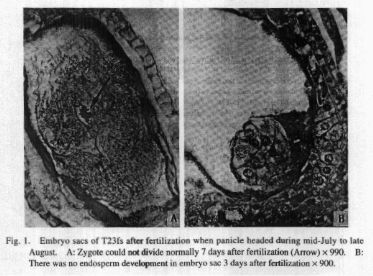male sterility in rice
X.D. LiuandY.G.Lu
Department of Agronomy, South China Agricultural University,
Guangzhou, China
|
|
Photoperiod and temperature sensitive genic male sterility
in rice has been widely reported. But photoperiod and temperature sensitive
female sterility of rice has not been reported so far. In this communication,
we report a photoperiod and temperature sensitive female sterile mutant,
T23fs, which was derived from the progeny of pollen culture derived plant
from the cross of C57 (Indica) x 02428 (Japonica). During 1996 to 1998,
T23fs was sown at different times under natural conditions of daylength
at Guangzhou (23°08’ N). It was found that panicles bore few seeds
when they headed during mmd-July to late August, and bore seeds at a high
rate when they headed during late-September to mid-October.
During sterility inducing period, the spikelet set no seeds
even when normal pollens of a different variety were sprinkled over their
stigmas. The morphology and structure of T23fs spikelets were normal and
they opened normally. By iodine staining, germination- test, and pollination-test,
it was found that the pollen of T23fs was highly fertile when panicles
flowered under favorable growing conditions from July to October. The embryo
sacs were observed 3 days and 7 days after self-fertilization by a whole
stain-clearing technique. No normal embryos were observed when panicles
flowered during mid-July to late August. On the other hand, normal embryos
developed when panicles flowered during late-September to mid-October.
By using semi-thin section technique, it was found that the structure of
embryo sac of T23fs was similar to normal rice, which had one egg cell,
two synergids, two polar-nuclei and one group of antipodals. There were
two reasons for T23fs sterility. The first was that the zygote could not
divide normally (Fig.lA). The second was that zygote could divide normally
but the young embryo could not develop normally because of lack of endosperm
(Fig. 1B). These results clearly showed that T23fs was a typical photoperiod
and temperature sensitive female sterile mutant. The female sterility was
caused in the early season with long-daylight and high temperature, and
it became fertile in the condition of late season with short-daylight and
“low” temperature. We considered that the female sterility of T23fs was
different from that in the cross of Indica x Japonica reported by Yokoo
(1984), also different from the female sterile mutant reported by Ling
et al. (1991).
|

|
Yokoo,
|
M., 1984. Female Sterility in an Indica-Japonica cross of
rice. Japan. J. Breed. 34: 219-227 (in Japa
|